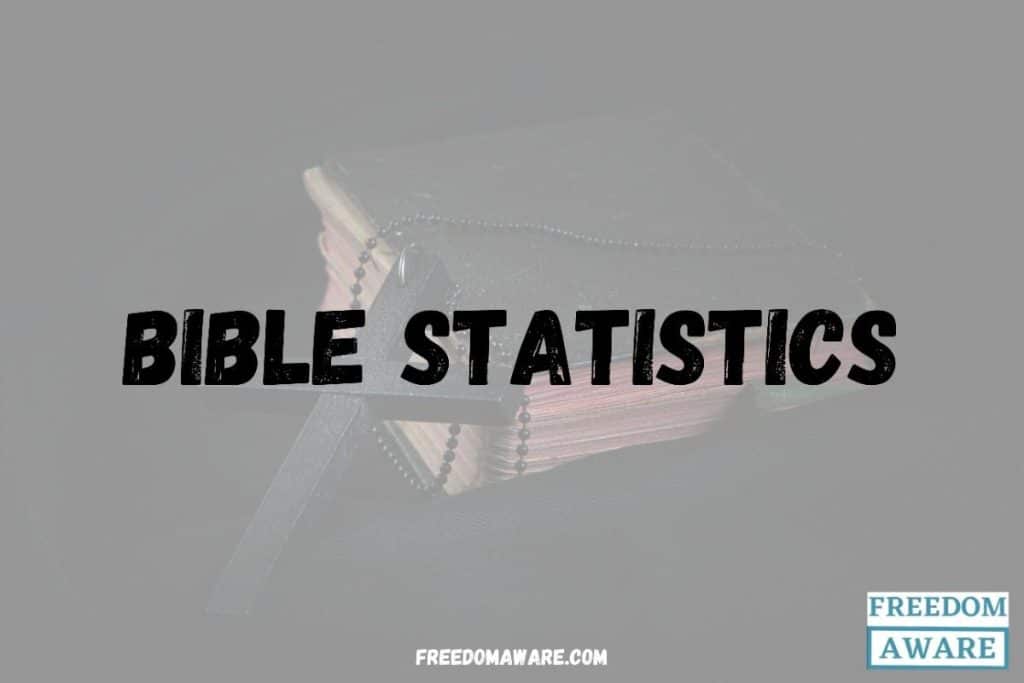
Here are some Bible statistics you should know;
The Bible stands as an unparalleled literary and historical monument, profoundly shaping the course of human civilization. Beyond its spiritual depth, it is a treasure trove of remarkable facts and figures. From its word count to its linguistic reach, the Bible’s statistics offer a captivating lens into the extraordinary impact of this timeless book.
Join us as we uncover surprising insights into the scriptures that have left an indelible mark on history.
Key Statistics- (Editor’s Pick) Bible Statistics
- The Bible was originally written in Hebrew.
- The Bible is the best-selling book of all time, with over 5 billion copies sold worldwide.
- The Bible remains a hot commodity, with over 100 million copies sold every year.
- A staggering 90% of American homes own at least one Bible, making it ubiquitous in many households.
- The Bible has been translated into over 2,000 languages, making it one of the most translated books in history.
- There are 66 books in the Bible.
- The Bible is the most quoted book in history, with its phrases, verses, and stories permeating art, literature, music, and film.
- A remarkable 80% of Christians read the Bible daily, demonstrating its continued relevance and importance in the lives of millions worldwide.
- ‘Amen’ is the Last word of the Bible.
General Bible Statistics
- The Bible is a product of over a thousand years of writing, with its earliest books dating back to around 1200 BC and the latest completed by 100 AD. (Source)
- The original Bible lacked the familiar chapter and verse divisions, making memorization challenging. The Geneva Bible introduced this structure, revolutionizing Bible study. (Source)
- The Bible was originally written in Hebrew. (Source)
- The Bible’s longest word is Mahershalalhashbaz. (Source)
- The Bible contains a vast number of divine promises, totaling approximately 7,147 according to “All the Promises of the Bible.” (Source)
- Public opinion on the Bible’s influence in American culture is divided, with nearly one-quarter believing it is excessive and over two-fifths feeling it is insufficient. (Source)
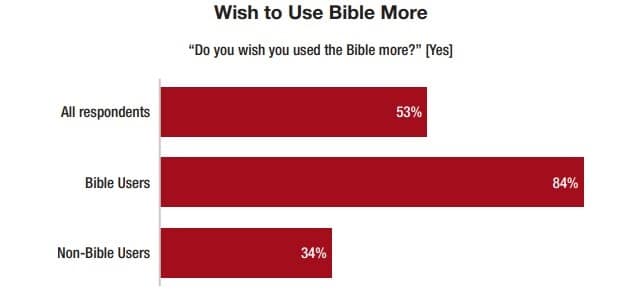
- More than half of American adults (53%) say yes, they do wish they
- read the Bible more. (Source)
- Most American adults desire to read the Bible more frequently, including a substantial portion of those who rarely or never engage with it. (Source)
- Bible ownership among practicing French Catholics has increased slightly since 1988, with two-thirds of this group owning a copy. (Source)
- While Bible usage is growing among Gen Z, it is declining among Millennials. In contrast, a larger proportion of Gen Zers report increased Bible use compared to those who report decreased use. (Source)
- A small but notable percentage of Americans find the Bible’s language challenging to connect with or uninteresting. (Source)
- China is currently the biggest producer of Bibles in the world with over 600 employees. (Source)
- Black Americans demonstrate the highest level of Bible engagement compared to other ethnic groups, with nearly one-third actively using Scripture. (Source)
- The New Testament is the preferred section of the Bible among most Americans surveyed, although a significant minority admit to limited Bible familiarity. (Source)
- With 803 occurrences, Moses, the preeminent figure in Judaism, ranks as the Bible’s third most-mentioned name, following David, Israel’s third King. (Source)
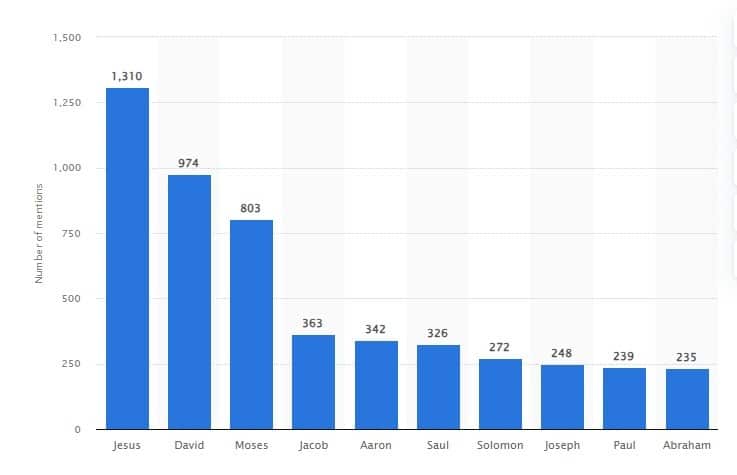
- The name Jesus dominates the biblical text, despite only appearing in the New Testament. (Source)
- A notable 71% of Americans express a keen interest in delving deeper into the Bible and the life of Jesus, indicating a substantial public curiosity about spiritual matters. (Source)
- The Bible’s influence spans the globe, with translations available in a staggering 3283 languages across 167 nations. (Source)
- A significant portion of Americans, 44%, believe the nation would decline without the Bible, while only 14% disagree. (Source)
- The belief in the Bible’s role in character development is prevalent among Americans, with 50% affirming its importance for children, an uptick from the previous year’s 46%. (Source)
- The Bible’s enduring popularity is evident in its print circulation, with an estimated 5 to 7 billion copies distributed worldwide. (Source)
- The Bible’s contemporary relevance is underscored by the exceptional sales of the “Message” translations, exceeding 20 million copies in just 25 years, according to Rev. Peterson’s literary agency. (Source)
- Public opinion in the UK is skeptical of the Bible’s Christmas narrative, with over half doubting its historical accuracy. Conversely, less than a third find it wholly or partially believable. (Source)
- The biblical figure Methuselah holds the record for the longest human lifespan, reaching an astonishing age of 969 years. (Source)
- With annual sales surpassing 100 million copies, the Bible indisputably reigns as the world’s bestselling book. (Source)
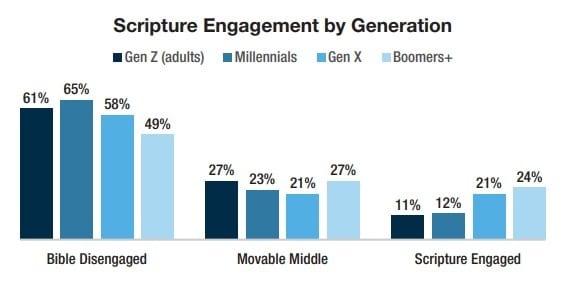
- Older generations (Boomers) exhibit higher levels of Bible engagement compared to younger generations (Millennials and Gen Z). (Source)
- Up to 65 million American adults are open to the message of the Bible. (Source)
- The biblical figure Methuselah holds the record for the longest human lifespan, reaching an astonishing age of 969 years. (Source)
- The Bible’s transformative impact is evident in the lives of many, with 58% of people reporting positive life changes attributed to its message. This represents a slight increase from the previous year and a notable surge among Gen Z adults, rising to 54%. (Source)
- The Bible holds the unfortunate distinction of being the world’s most stolen book. Its widespread availability in public spaces, such as hotels and hospitals, has made it an easy target for theft. (Source)
Reading The Bible Statistics
- Regular Bible engagement correlates with increased spiritual engagement, as 22% of monthly readers reported heightened faith commitment and 13% indicated greater generosity. (Source)
- A generational divide emerges in Bible reading habits, with Millennials and Gen X demonstrating a preference for digital formats (27% and 26% respectively), compared to the significantly lower adoption rates among Boomers and Elders (9% and 2%). (Source)
- Traditional formats remain dominant among older Bible readers, with 91% expressing a preference for print over other mediums. (Source)
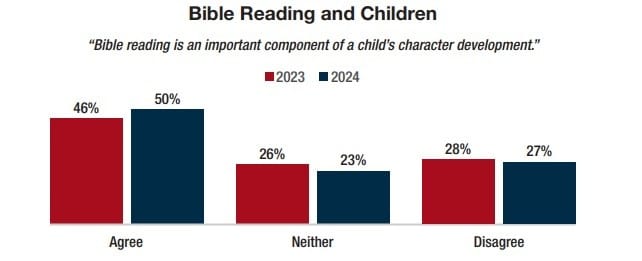
- In 2024, half of Americans believe Bible reading is essential for their children’s development, an increase from 46% the previous year. (Source)
- A consistent minority of Americans, comprising 11%, engage in daily Bible reading. (Source)
- Demographic trends in Bible reading reveal a stark contrast between generations, with millennials exhibiting the lowest rates and those over 70 demonstrating the highest frequency. (Source)
- The digital age has influenced Bible engagement, as 81% of online church attendees report independent Bible reading compared to 67% of primarily in-person attendees. (Source)
- Despite evolving media, the desire to read the Bible persists, with 56% of Americans expressing interest in 2019. (Source)
- Structured Bible engagement is common among Americans, with 27 million following specific schedules, study plans, or programs. (Source)
- Personal preference dictates Bible reading for many Americans, with 31% of practicing Christians and 35% of non-practicing Christians admitting to selecting passages based on their mood. (Source)
- The Bible has inspired compassion for those in need, with 130 million Americans citing its influence on their support for refugees and war victims. (Source)
- Marital status significantly impacts Bible engagement among American adults, with the separated demonstrating the highest likelihood (52%) and never-married individuals exhibiting the lowest (30%). (Source)
- The primary motivation for Bible reading among Americans is spiritual connection, with 47% citing a desire to draw closer to God. Seeking wisdom and finding comfort follow as secondary reasons, at 20% and 15% respectively. A small percentage (2%) read the Bible out of obligation. (Source)
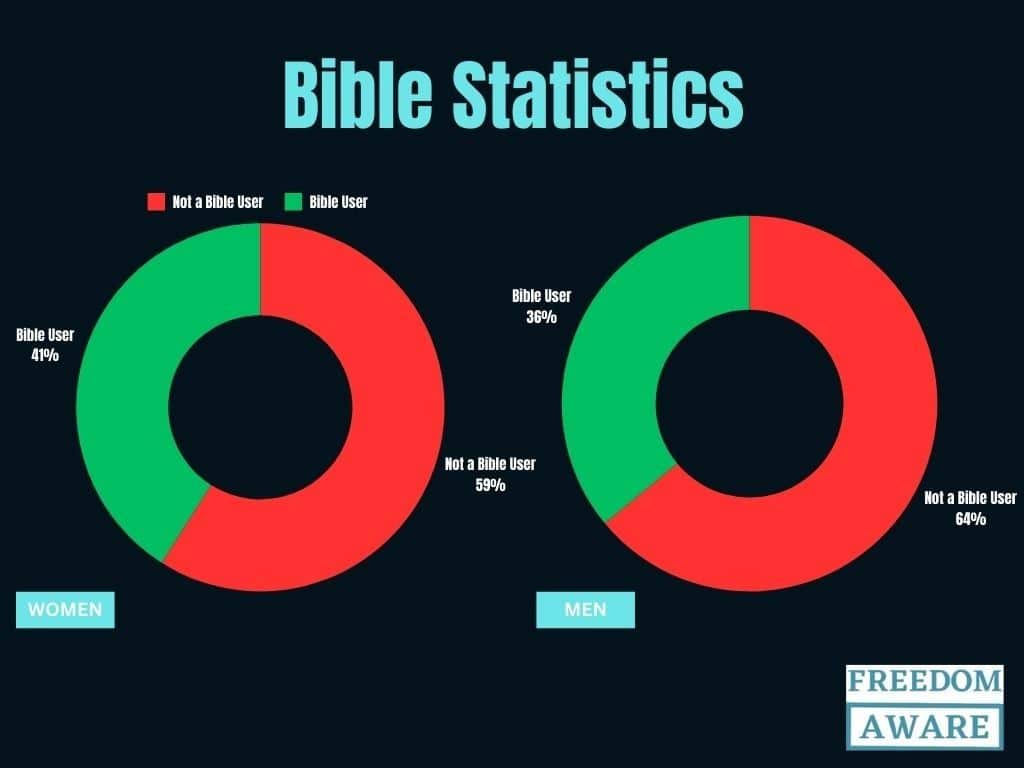
- Women are more engaged with the Bible than men, with 41% of women identifying as Bible users compared to 36% of men. (Source)
- Age correlates with Bible engagement, with older adults (Elders) displaying the highest usage (48%) and younger generations (Gen Z) the lowest (30%). (Source)
- Religious affiliation strongly influences Bible use, with Evangelical and Historically Black Protestants exhibiting the highest rates (70% and 68% respectively), while Catholics demonstrate lower engagement (37%). (Source)
- Racial disparities in Bible use are evident, with Black Americans leading at 57%, followed by Whites at 35% and Asians at 27%. (Source)
The King James Statistics and Facts (Bible Statistics)
- The King James Version made its debut in 1611. (Source)
- The King James Version of the Bible took seven years to complete its translation process. (Source)
- The King James Bible is a cornerstone of the modern English language. (Source)
- The King James Bible is a vast compilation, containing two sections, 66 books, 783,137 words, and a staggering 3,116,480 letters. (Source)
- The Old Testament comprises 39 books, while the New Testament consists of 27. (Source)
- The Bible’s rich linguistic tapestry includes 8,674 unique Hebrew words, 5,624 Greek words, and 12,143 English terms. (Source)
- With 1,189 chapters and 31,102 verses, the Bible is a substantial literary work. (Source)
- The Old Testament contains 929 chapters and 23,145 verses, while the New Testament has 260 chapters and 7,957 verses. (Source)
- The structure of the Bible we know today is the result of careful organization. Cardinal Hugo de S. Caro introduced chapters in 1238, and Robertus Stephanus added verse divisions in 1551. (Source)
- Psalms holds the distinction of being the longest book in the Bible with 150 chapters, while Psalm 119 claims the title of the longest chapter with 176 verses. (Source)
- The Bible’s extremes of length are evident in Esther 8:9, the longest verse with 78 words, and John 11:35, the shortest with just two words: “Jesus wept.” (Source)
- The books of 3 John and Psalm 117 are the shortest in terms of word count. (Source)
- The Bible is a product of an extraordinary period, composed over 1,500 years by 40 diverse authors across three continents, using three languages (Hebrew, Aramaic [Chaldee], and Greek). (Source)
- The Old Testament is a collection of historical, poetical, and prophetic writings, with 17 books in each category (Source).
- The New Testament presents four Gospels, 21 letters, and the prophetic book of Revelation. (Source)
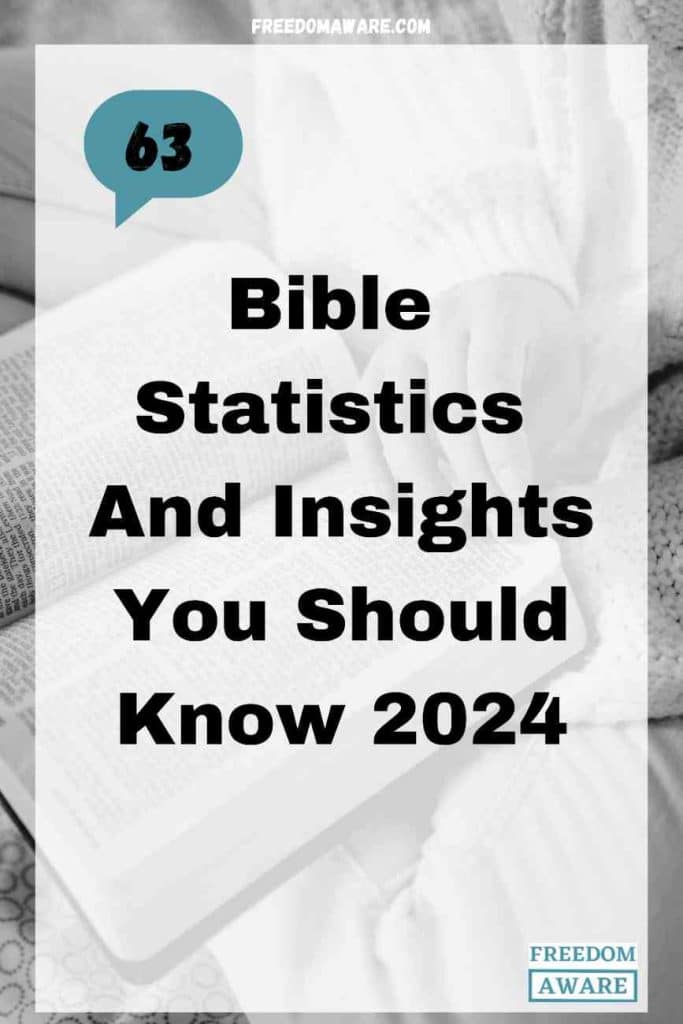
Final Thoughts (Bible Statistics)
The data presented here unveils a captivating portrait of the Bible – its historical depth, global reach, and enduring influence.
From impressive sales to linguistic complexity, the numbers tell a compelling story. Whether you approach the Bible as a scholar, a spiritual seeker, or simply an interested reader, these statistics offer a unique perspective on this timeless text. As you engage with its pages, consider the extraordinary journey it has undertaken and the profound impact it continues to make on the world.


Leave a Reply